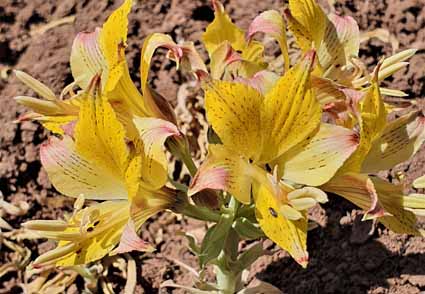Abstract
A recently described species of Chilean Alstroemeria, A. piperata, is endemic to the Mediterranean region and characterized by having storage roots covered with whitish hairs. It is a highly endangered species, consisting only of a single population with few individuals. Its chromosomes are 2n = 16, typical for the genus, but they possess unique secondary constrictions. A molecular analysis of plastid DNA revealed no single nucleotide polymorphisms, which suggests that processes of phenotypic stabilization and incipient genetic isolation may be occurring within the species.
References
- Baeza, C., Rojas, G. & Ruiz, E. (2011) El cariotipo fundamental de Alstroemeria patagonica Phil. (Alstroemeriaceae). Boletín de la Sociedad Argentina de Botánica 2011: 313–315. https://doi.org/10.4067/S0717-66432011000200019
- Baeza, C., Toro, O., Ruiz, E., Finot, L., Carrasco, P. & Villalobos, N. (2018a) Polimorfismo de tamaño entre cromosomas homólogos, un caso extremo en Alstroemeria pulchra Sims. (Alstoemeriacaeae), especie endémica de Chile. Gayana Botánica 75: 663–666. https://doi.org/10.4067/S0717-66432018000200663
- Baeza, M., Finot, V., Ruiz, E., Carrasco, P., Novoa, P., Rosas, M. & Toro-Núñez, O. (2018b) Cytotaxonomic study of the Chilean endemic complex Alstroemeria magnifica Herb. (Alstroemeriaceae). Genetics and Molecular Biology 41: 434–441. https://doi.org/10.1590/1678-4685-gmb-2017-0157
- Baeza, C., Toro, O., Ruiz, E., Santos, D., Salvatierra, A. & Thielemann, E. (2022) Divergence among the subspecies of Alstroemeria garaventae Ehr. Bayer (Alstroemeriaceae) on fundamental karyotype and chloroplast DNA data. Gayana Botánica 79: 140–146. https://doi.org/10.4067/S0717-66432022000200140
- Bayer, E. (1987) Die Gattum Alstroemeria in Chile. Mitteilungen der Botanischen Staatssaammlung München 24: 1–362.
- Borchsenius, F. (2009) FastGap 1.2 (1.2). Available from: http://www.aubot.dk/FastGap_home.htm (accessed 5 December 2023).
- Clement, M., Snell, Q., Walke, P., Posada, D. & Crandall, K. (2002) TCS: Estimating gene genealogies. In: Proceedings of the 16th International Parallel and Distributed Processing Symposium. 7 pp. https://doi.org/10.1109/IPDPS.2002.1016585
- Duminil, J. & Di Michele, M. (2009) Plant species delimitation: a comparison of morphological and molecular markers. Plant Biosystems 143: 528–542. https://doi.org/10.1080/11263500902722964
- Finot, V., Baeza, C., Muñoz-Schick, M., Ruiz, E., Espejo, J., Alarcón, D., Carrasco, P., Novoa, P. & Eyzaguirre, M. (2018) Guía de campo de las alstroemerias Chilenas. Corporación Chilena de la Madera, Concepción, 295 pp.
- Graham, R. (1833) Description of several new or rare plants which have lately flowered in the neighborhood of Edinburgh, and chiefly in the Royal Botanic Garden. Edinburgh New Philosophical Journal 15: 181–184.
- Herbert, W. (1837) Amaryllidaceae. Ridgway, London, 428 pp.
- Herbert, W. (1843) Miscellaneous matters of the Botanical Register. Edward’s Botanical Register 29: 1–85.
- Kalyaanamoorthy, S., Minh, B.Q., Wong, T.K.F., Von Haeseler, A. & Jermiin, L.S. (2017) ModelFinder: fast model selection for accurate phylogenetic estimates. Nature Methods 14: 587–589. https://doi.org/10.1038/nmeth.4285
- Katoh, K. & Standley, D.M. (2013) MAFFT multiple sequence alignment software version 7: mprovements in performance and usability. Molecular Biology and Evolution 30: 772–780. https://doi.org/10.1093/molbev/mst010
- Lanfear, R., Calcott, B., Ho, S.Y.W. & Guindon, S. (2012) PartitionFinder: combined selection of partitioning schemes and substitution models for phylogenetic analyses. Molecular Biology and Evolution 29: 1695–1701. https://doi.org/10.1093/molbev/mss020
- Levan, A., Fredga, K. & Sandber, A. (1964) Nomenclature for centromeric position on chromosomes. Hereditas 52: 201–220. https://doi.org/10.1111/j.1601-5223.1964.tb01953.x
- Leigh, J.W. & Bryant, D. (2015) POPART: full‐feature software for haplotype network construction. Methods in Ecology and Evolution 6: 1110–1116. https://doi.org/10.1111/2041-210X.12410
- Linnaeus, C. (1762) Planta alströmeria. Amoenitates Academicae 6: 247–262.
- Loddiges, C. (1827) Coloured delineations of plants from all countries. The Botanical Cabinet 13: t1271–t1280.
- Molina, G.I. (1872) Saggio sulla storia naturale del Chili. Aquino, Bologna, 368 pp.
- Muñoz-Schick, M. (2003) Notas nomenclaturales sobre Alstroemeria (Alstreoemeriaceae). Noticiario Mensual del Museo Nacional de Historia Natural 352: 22–24.
- Muñoz-Schick, M., Eyzaguirre, M.T. & Moreira-Muñoz, A. (2019) Rediscovery of a species and its new classification as a subspecies of Alstroemeria garaventae (Alstroemeriaceae) de Chile. Gayana Botanica 76 (2): 247–252. https://doi.org/10.4067/S0717-66432019000200247
- Nguyen, L.T., Schmidt, H.A., von Haeseler, A. & Minh, B.Q. (2015) IQ-TREE: a fast and effective stochastic algorithm for estimating maximum-likelihood phylogenies. Molecular Biology and Evolution 32: 268–274. https://doi.org/10.1093/molbev/msu300
- Okonechnikov, K., Golosova, O. & Fursov, M. (2012) Unipro UGENE: a unified bioinformatics toolkit. Bioinformatics 28: 1166–1167. https://doi.org/10.1093/bioinformatics/bts091
- Peruzzi, L. & Eroglu, H. (2013) Karyotype asymmetry: again, how to measure and what to measure? Comparative Cytogenetics 7: 1–9. https://doi.org/10.3897/compcytogen.v7i1.4431
- Philippi, R.A. (1896) Plantas nuevas Chilenas. Anales de la Universidad de Chile 93: 143–166.
- Philippi, R.A. (1858) Plantarum novarium Chilensium. Linnaea 29: 1–110.
- Rieseberg, L.H. & Willis, J.H. (2007) Plant speciation. Science 317: 910–914. https://doi.org/10.1126/science.1137729
- Ruiz, H. & Pavón, J. (1802) Flora Peruviana et Chilensis 3: 1–95.
- Sanso, A. (2002) Chromosome studies in Andean taxa of Alstroemeria (Alstroemeriaceae). Botanical Journal of the Linnaean Society 138: 451–459. https://doi.org/10.1046/j.1095-8339.2002.00019.x
- Sanso, A. & Hunziker, J. (1998) Karyological studies in Alstroemeria and Bomarea (Alstroemeriaceae). Hereditas 129: 67–74. https://doi.org/10.1111/j.1601-5223.1998.t01-1-00067.x
- Schlick-Steiner, B.C., Arthofer, W. & Steiner, F.M. (2014) Take up the challenge: opportunities for evolution research from resolving conflict in integrative taxonomy. Molecular Ecology 23: 4192–4194. https://doi.org/10.1111/mec.12868
- Seigler, D. & Ebinger, J. (2005) New combinations in the genus Vachellia (Fabaceae: Mimosoideae) from the New World. Phytologia 87: 139–178.
- Simmons, M.P. & Ochoterena, H. (2000) Gaps as characters in sequence-based phylogenetic analyses. Systematic Biology 49: 369–381. https://doi.org/10.1093/sysbio/49.2.369
- Sims, J. (1823) Flower-garden displayed. Botanical Magazine 50: 2356–2440.
- Watson, J., Flores, A. & Rojas, G. (2018) A rare, narrowly endemic new species of Alstroemeria (Alstroemeriaceae) from the transversal Andean foothills of Central Chile, and its interesting ecology. International Rock Gardener 102: 25–54.


